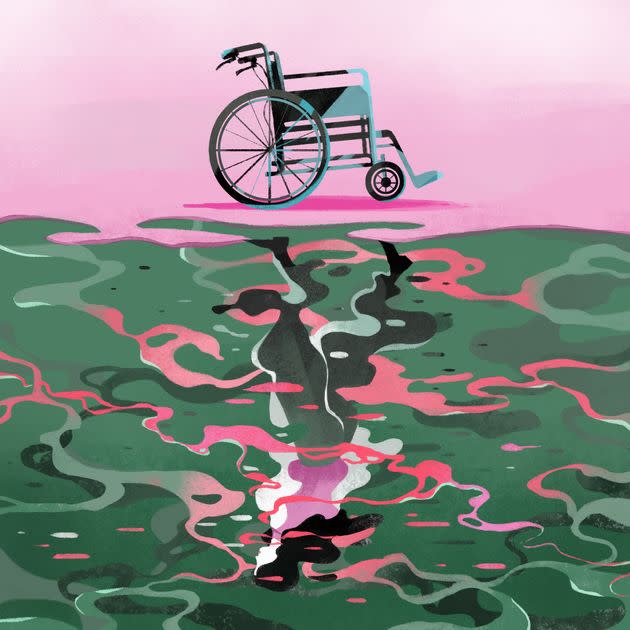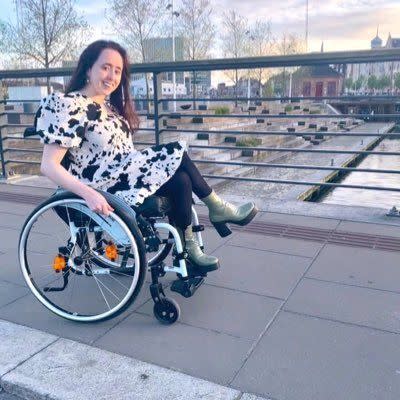I've Used A Wheelchair Since I Was 19. Why Don't I Need It In My Dreams?

In my dreams, I can walk. (Photo: Jianan Liu/HuffPost)
The internet never stops spilling over with dream interpretations. Lifestyle sites and social media posts claim to be able to make sense of your tangled subconscious thoughts and visions, with no scientific reasoning whatsoever. I’ve read that dreaming about teeth falling out is a sign of anxiety, that dreaming of fish could mean you’re pregnant, and that being chased in dreams signifies avoidance. Somehow, there’s no convenient explanation for the absence of my wheelchair in my dreams.
I was diagnosed with Friedreich’s ataxia, a progressive neuromuscular condition, when I was 13 years old. I remained ambulatory, with the help of mobility aids like canes and crutches, until I was 19, when I started to use a wheelchair since the progression of my condition made it impossible for me to deny help any longer. Until that time, I wasn’t able to accept my disability, and so I was not able to accept that I needed a wheelchair.
That was seven years ago. Since then, my conscious mind doesn’t dream of walking again ― for me, this is unrealistic and medically impossible ― but that has not stopped my unconscious mind from dreaming of an alternate reality where I don’t need to use my wheelchair. It seemed bizarre, but when I spoke to other wheelchair users, I learned that many of them also dream of themselves walking with no assistance.
My subconscious seems wildly selective, conjuring up recreations of insignificant events in my day-to-day life but not reflecting my physical reality. My mind could recall the faces of acquaintances I see sitting in a sea of people in my university lectures but not the wheelchair I’ve been using for my entire adult life. Why does there appear to be such a disconnect between my mind and my body?
At first, I theorized that this dissonance was some form of denial, a stubborn unwillingness to accept my disability. Although dream science is a very murky area and there isn’t much that neurological and psychological experts can say for sure, I sought out some professionals to help figure out if my theory was true.
“What you experienced is typical for people who suffer motor and sensory deficits, whether of cortical, spinal or peripheral origin,” said Mark Solms, neuropsychologist, psychoanalyst and the director of neuropsychology at the Neuroscience Institute of the University of Cape Town. Solms first reported this phenomenon in his 1997 book ”The Neuropsychology of Dreams.” “Hemiplegic patients can move normally in their dreams, cortically blind patients can see, aphasics can speak, etc.”
What he’s saying, essentially, is that disabilities don’t always translate from reality to dreams. It’s a different world altogether when we’re asleep.

Niamh Ní Hoireabhaird wondered what was behind the mind/body disconnect she felt when she walked without help in her dreams. (Photo: Niamh Ní Hoireabhaird)
The “why” is a bit more elusive. Solms surmised that “dreaming does not involve here-and-now activation of the relevant sensory-motor structures in the central nervous system but rather activation of structures in long-term memory.” Following this theory, my subconscious mind is simply dwelling on the past rather than the present. I wonder if lingering on the past is a coping mechanism or just something that our brains naturally do in this state.
While dreams are often just amalgamations of random thoughts and memories, there are psychologists who believe that they can hold important meaning. “There are several well-validated, objective methods of analyzing dream content which have been used in sound scientific research,” Solms told me.
Sigmund Freud believed dream interpretation was essential in the understanding of human existence. His theories on dreams were first published at the turn of the 20th century in ”The Interpretation of Dreams,” where he documented his personal experiences. Freud’s belief that dreams have meaning was starkly contrary to the general scientific consensus of his time. Many of Freud’s theories have fallen out of favor with modern psychologists, but Solms believes that his dream theories still hold relevance today.
It makes sense that scientists and non-scientists alike are so fascinated by the visions we conjure when we’re not conscious. Dream analysis has played a significant role in certain religions and cultures; In ancient Greece, it was thought that dreams were a supernatural form of communication from the gods. If I were living in ancient Greece, what would the gods be trying to communicate to me?
Maybe Freud was right when he said dreams were wish fulfillments.
Like many teenagers, I struggled with my identity. I was a wheelchair user but I did not want to be. Was my negative attitude preventing my wheelchair from making an appearance in my dreams, where I’d found a different version of myself?
A study of the dreams of paraplegic people found that a number of other wheelchair users experienced this phenomenon. The researchers hypothesized that it could be the subconscious mind mirroring the actions we see in everyday life. I see people walking and using their legs in daily life and in the media, so my mind mimics that in my dreams.
This made sense to me. Because I was surrounded by ambulatory people who didn’t use wheelchairs, it made sense that that’s what my subconscious mind perceived as “normal.” It was then that I realized how much community matters when it comes to conceptualizing what’s normal to me.
I turned to Twitter to expand my social circle, since the platform is home to an amazing community of disability advocates and activists. It was through the platform that I first connected with wheelchair user and former Irish paralympian Eimear Breathnach, who shared her dream experiences with me. “I used to walk in my dreams but now I’m not quite in a chair either,” she recalled, describing her movements as “floating .. but restricted.”
Breathnach’s husband, also a wheelchair user, often dreams of using a bike ― but then cannot walk when he stops cycling. I can understand this, considering Solms’ observation that disability might never fully translate into dreams.“Nobody has systematically studied how long it takes for paralysis, ataxia, hemianopia, etc., to appear in dreams after clinical onset,” Solms said. But in his experience, “it typically takes years and it is never complete.”
During my journey, advocates in the disability community taught me that “disability” is not a dirty word, and refusing to accept who I am and the help I need was only hurting myself and my quality of life. It was only earlier this year that I began to lose my ability to walk in my dreams. I don’t believe that it was just a coincidence that my first dream in which my wheelchair played a central role came very recently, just as my perspective on my disability began to shift.
Speaking from personal experience, Dermot Devlin, disability activist and wheelchair user, attributes this to the “deconstruction of inner-ableism.” Devlin suggests that once I accepted who I am and came to the realization that I didn’t want to change a.k.a. “be cured,” my dreams revealed an updated, if you will, version of myself. I believe it.
Maybe Freud was right when he said dreams were wish fulfillments. It is incredibly freeing to align who I am with how I wish to see myself. I want that for everyone who’s ever struggled with internalized-ableism. But one can only dream.
This article originally appeared on HuffPost and has been updated.

